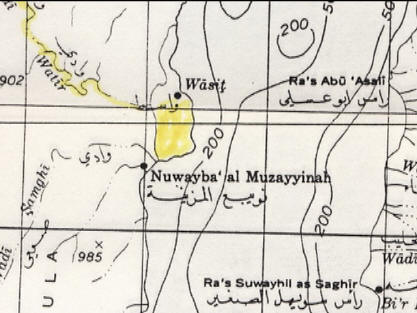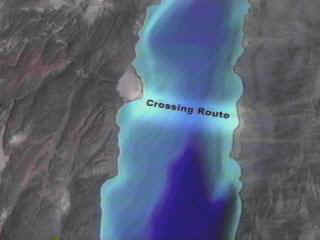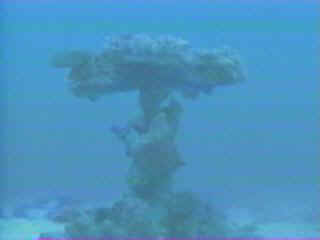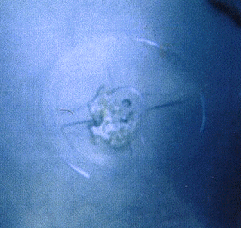Moses and the Israelites
The Bible tells us approximately 3,500 years ago, Moses parted the Red Sea and led the Israelites out of Egypt across to the other side. Then, when the Egyptian chariots crossed after them in pursuit, God caused the wheels to come off the chariots and the waters to quickly recede upon them, drowning all Pharaoh's army (please read Exodus chapter 14).

There is a traditional route of the Exodus which has the children of Israel wading in shallow water through an area north of the Gulf of Suez while the tide was out. This area cannot be the crossing site as it does not match the biblical account. A shallow area of water could not drown all of the Egyptian army. Also, they were to leave Egypt proper before encountering the Red Sea crossing. After crossing the Red Sea, the Bible says they encountered the mountain of God or Mount Sinai which is in Midian. Midian is not in the area we call today the Sinai Peninsula. It is instead in Saudi Arabia and can be found on most maps in that location. The traditional Mt. Sinai was "found" by Constantine's "psychic" mother who in the fourth century went around the Holy Land pointing out various sites as the "authentic" biblical sites, such as the birthplace of Christ, the church of the Holy sepulchre (which was a pagan temple during her time), etc. There is no archaeological evidence of the forty year existence of the children of Israel in the Sinai Peninsula.
The Red Sea Crossing Site Found by Ron Wyatt
The children of Israel lived in the Nile delta area or the land of Rameses, and first encamped at the northern end of the Gulf of Suez or Succoth at the beginning of the Exodus. This was the first point where they went into the camping mode. Then they travelled through the wilderness of the Red Sea, or what we call today the Sinai Peninsula, and encountered the Gulf of Aqaba. (I Kings 9:26 calls this the Red Sea.)

Courtesy of www.arkdiscovery.com
When travelling through "the wilderness of the Red Sea" Ex.13:18, escaping Pharaoh's army, God told Moses to turn south, so they headed through a wadi or canyon area that is called the Wadi Watir which led to the sea. The Bible in Ex. 14:3 says, "They are entangled in the land, the wilderness hath shut them in." When arriving at the beach, the children of Israel felt trapped, as they could not turn back, nor head north because at the northern end of the beach was a three story, Egyptian military fortress which is still standing today undergoing restoration. Additionally there were mountains obstructing their escape. To the south the mountains came down to the sea, as mentioned by Josephus, "For there was [on each side] a [ridge of] mountains that terminated at the sea, which were impassable by reason of their roughness, and obstructed their flight" Antiquities of the Jews, Bk. 2, 15-3. You can see the mountains at the beach today. The people were about to turn against Moses because he had led them to an area where they were trapped and would surely die, or so they thought.

Courtesy of www.arkdiscovery.com
If one looks on a map for a beach area large enough for 2 million people to encamp on the gulf there is only one candidate: Nuweiba Egypt. The beach at Nuweiba is extremely large and could have accommodated a large number of people at the time of Moses. Pi-Hahiroth means, mouth of the hole, which we would apply to the mouth of the canyon above, as mentioned in The Exodus Revealed DVD. Migdol is a fortress, which we would apply to the ancient fort which is located at the narrowest point on the beach where the gulf and the mountains are in close proximity.
Wadi Watir had the Children of Israel "entangled." Exit point at the large beach at Nuweiba
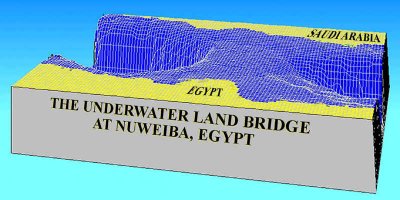
|
Kevin Fisher at the red granite column, marking the crossing site (Oct. 2005) |
The Granite Columns of Solomon Ron Wyatt found this column lying at the edge of the water in 1978. It matches one on the other side of the gulf in Saudi Arabia which had the inscriptions intact. The Hebrew words Mizram (Egypt), death, water, pharaoh, Edom, Yahweh, and Solomon were on that column. Apparently one can conclude King Solomon had these columns erected 400 years after the miracle of the crossing of the Red Sea on dry land. Solomon's sea port was at the northern tip of the Gulf of Aqaba at Eilat (I Kings 9:26) and he was very familiar with the Red Sea crossing site, as it was in his neighborhood. The Bible even mentions this column! Isaiah 19:19, "In that day there will be an altar to the Lord in the midst of the land of Egypt, and a pillar to the Lord at its border." You can visit the beach today and see the column in person. |
|
The name Nuweiba is short for Nuwayba' al Muzayyinah which means "Waters of Moses Opening". This is amazing! At the exact spot where the crossing took place, we have the site confirmed by maps. |
|
|
The Bible account of the Exodus tells us that God caused a "strong east wind" to blow the waters back so the people could walk ten miles through the Red Sea to safety in Arabia. The crossing path is about a quarter to a half mile wide and is on a gradual slope down to the bottom of the Red Sea and then up to the Saudi beach. On either side of this path are the depths of the Red Sea, the Eilat Deep and the Aragonese Deep, each 3000 and 5000 feet deep respectively.
Chariot Wheels Found in the Sea at Nuweiba
The Bible says the Egyptians pursued the Israelites into the opened sea. But it was a trap set by God. It says when they were fully into the crossing, "He threw the army into confusion caused the wheels of their chariots to fall off". He then caused the sea to return to its place and the entire Egyptian army was swept into the sea. Based on this account, we should find chariot parts at the bottom of the sea at the supposed crossing point, right?
|
|
|
Above, chariot wheels fixed to axels standing at attention on the seabed
|
|
|
Above, left, photo taken of a gilded chariot wheel that remains on the sea floor. It was found by Ron Wyatt using a molecular frequency generator from his boat above, after he set the equipment to search for gold. The Bible said all the chariots of Egypt and 600 "choice chariots", or gold veneered models, were in the army pursuing God's people. It is speculated there were 20,000 chariots destroyed that day. Above, right, is a drawing of a four spoke chariot found in an Egyptian tomb from the same time period. According to ArkDiscovery.com, four, six and eight spoke wheels are found here in the gulf, and were only used at the same time during the 18th dynasty or 1446 BC when the exodus took place.
Watch the Video ![]()
Watch Red Sea Crossing video from ArkDiscovery.com DVD (27 minutes)
Conclusion
For a long time, westerners and non-Christians have denied the Biblical story of Moses and the Red Sea crossing. To this day, people who have never been to the area will deny the clear evidence brought back by Ron Wyatt and others. But now we know that the Bible was true all along. We can trust the Word of God. But where did the Israelites go after they crossed into Arabia? Read on to learn about the real Mount Sinai.
Please visit these other sites for more photographs and other evidences.
wyattmuseum.com
www.ronwyatt.com
www.throneofgod.com
www.biblediscoveries.com
www.noahsark-naxuan.com
www.biblediscoveries.com
www.arkdiscovery.com/red_sea_crossing.htm
Post a Comment
No comments found.



